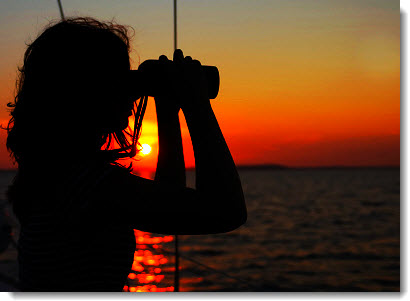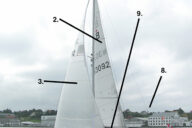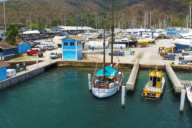Sail in inland, coastal or offshore waters, and you will encounter tugs and their tows. What you see may or may not tell the entire story. For example, you will see the tugboat first. But is he or she towing or not?
How can you determine whether –in accordance with the Navigation Rules–the vessel you see will be considered just another power driven vessel or a vessel engaged in towing. Why is this of vital importance to the sailing skipper?
I believe first and foremost — “trust but verify”. The tug skipper and crew might have forgotten to display the proper day shapes or (at night or in periods of reduced visibility) special lights required for a vessel engaged in towing (find out more about day shapes and lights in the member’s eBook–“Navigation Rules Made Easy).
Which is one of the primary reasons that I believe one of the most important navigation tools for safety will be a binocular. I would not think of going onto the water without them. And they need not be the most expensive on the block. My current binocular cost less than $125 on sale (West Marine) and has provided superb service in a variety of conditions. Look for the phrase ‘nitrogen charged’ in the specs. This indicates a waterproof–not just water resistant–binocular.
Why You Might Not See a Tug’s Towline!
Consider that vessels engaged in towing have tow lines and gear that stretch from the stern of the tug to the bow of the boat, barge, or ship astern. And you may or may not see all of the tow line. Commercial towing hawser (tow line) can consist of large diameter wire rope that runs from stern (of the tug) to bow (of the vessel being towed).

Notice how the towing hawser (heavy towline) disappears astern of the tug. Vessels being towed astern can be 1/2 mile or further aft of the tug. Follow the steps below to avoid catastrophic damage or serious or fatal injury. (Illustration from the member’s eBook “Navigation Rules Made Easy” by Captain John).
Part of the art requires that the tow line has enough slack–called “catenary”. This keeps a slight “U” shape in the tow line. The objective will often be to keep that tow line just at or below the surface of the water. And therein lies the dilemma for other boaters.
You may or may not see the tow line. What now, skipper? Take these three vital steps anytime you sight a tug and are unable to see the entire length of tow line that runs from her stern to the bow of the vessel being towed.
*Note:
We are not talking about “Sea Tow” vessels. For the most part, those are small boats that use short tow lines astern that will be visible most all of the time. Once inside sheltered waters, they will “make up” the tow alongside (tow-on-the-hip). Here, we will discuss large commercial tugs with full crews and complex towing gear.
Three Steps to Avoid Tow Line Entanglement
1. Use a binocular to scan behind the tug. Tows can be 1/2 mile or more aft of the tug stern. Some tugs may tow a string of vessels in line called a “tandem tow”. Scan well behind each towed vessel to check for other vessels being towed in tandem.
2. At night, look for two or three white lights in a vertical line on the tug’s mast. These indicate how far the tow lies behind the tug (2 white lights = less than 200 meters; 3 white lights = greater than 200 meters).
By day, tugs with a tow greater than 200 meters astern carry a black diamond shape high up in the rigging. The tow should also show this shape.
3. Avoid the temptation to pass astern of the tug. Stop or heave to until you see the vessel being towed and it passes your position. Vessels or barges being towed carry the same lighting as a sailboat–side lights (green to starboard, red to port) and a stern light (white). They can be tough to spot in a seaway. Proceed after you have made positive identification and both vessels have passed by you.
~~~~~~~~~~~~~~~~~~~~~
Learn those vital sailing safety tips to sail safer on the busy waters of the world. Keep your small sailboat and sailing crew clear of commercial tugs and tows for sailing safety–wherever in the world your choose to sail or cruise!












